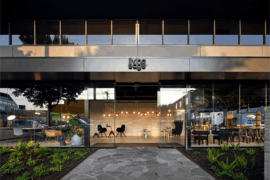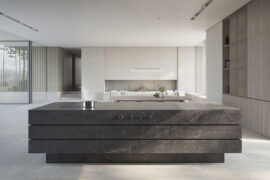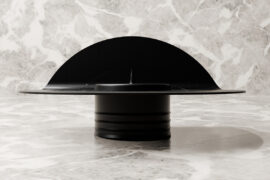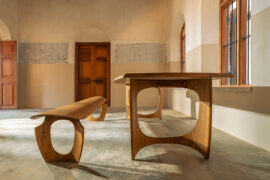During his trip to town for Singapore Indesign 2016, Italian designer Mario Mazzer takes time off and tells us about his major influences, the role of design today and his latest collection for OM Furniture.

indesignlive.sg
November 18th, 2016
Having launched his long-standing career by working alongside some of the greatest masters of Italian design, including Achille Castiglioni and Marco Zanuso, Mario Mazzer has become one of the pivotal contemporary figures in industrial design and architecture.
With projects encompassing a range of scales and typologies, Mazzer is the first one to admit that he always questions and challenges his own design beliefs, in order to foster new ideas and achieve well thought-out design concepts. Having recently visited Singapore to offer his take on hospitality design at the recent Singapore Indesign event at OM Furniture, Mazzer takes a moment to discuss the role of design in the increasingly global world and his latest projects, as diverse as his design expertise.
Who were your major influences during your early years of doing design? How have they shaped your design vision?
My cultural education is architectural and based on the Gestalt psychology. I have been very fortunate to have studied and grown professionally in Milan during the magic moment of Italian design. I have studied and worked with designers and architects who have made the history of Italian and, in many aspects, global design. I have spent time with people like Achille Castiglioni, Marco Zanuso and had friendly relations with all the major players who, although in different ways, tried to express a thought behind design.
How would you define your style and approach to design?
I think my design is very much influenced by the function-form relationship but I also find that the psychological aspect that a product can transfer to its user is very important. The culture of architectural history and, in particular, of design history, are the foundation on which my design rests.
Do you think the process of design has changed over the last several decades? If so, how?
In the past, the time span from design to industrial production took longer than today. Now, due to computer-aided design and 3D modelling, it is very fast. The mathematical model for the moulds is provided by us in the planning stages and, sometimes, meditation and reflection that should be made on prototypes are skipped.
I believe in design that is thought and weighted through drawing and then corrected and improved through prototyping.
You have actively participated in many design-centred conventions and conferences. Why is it important, in your opinion, for designers to stay involved in conversations and cultural debates about design?
Conferences help to make it clear to young people that design is not fashion. It is something more significant than just a beautiful form: it is culture.
What issues or topics of conversation pertaining to culture and design are interesting or most relevant to you today?
The global world brings us to make continuous comparisons to one another and to live very similarly to each other. I believe that in order to not miss the great cultural diversity, and to not flatten it into a single lifestyle, we must highlight the genius loci of every culture.
Having worked with design companies like Artemide, Cappellini and Poliform, among many others, do you have any favourite pieces that you have worked on over the years?
Through the years, we have changed and I do not regret anything I have designed, as not to extol any object or project I created in the past. I always feel more attached to the latest product I am realising because it represents who I am now and not who I was.
You have recently collaborated with OM Furniture on the Tiffany collection. What is the significance of this collection?
The Tiffany collection has been the product that allowed us to start a fruitful collaboration in the field of interior design for hotels.
What is the overarching concept behind the collections for OM?
The collections have a clear identity and are characterised by a contemporary design with pure lines. This is to facilitate the insertion in different living spaces.
What projects, collaborations or design events are you working on now?
Mario Mazzer Architects’ works span different fields of design: from small objects, such as a collection of professional sommelier titanium corkscrews, to the designs of large malls. In architecture, we are dealing with the construction of villas in Italy and abroad and with the construction of cellars with new technological and productive philosophical concepts. In the interior design field, we follow the creation of a chain of over a hundred wine bars in Russia and three hotels. In design, we are working for many Italian companies and, for many of them, we are also engaged in the artistic direction.
INDESIGN is on instagram
Follow @indesignlive
A searchable and comprehensive guide for specifying leading products and their suppliers
Keep up to date with the latest and greatest from our industry BFF's!

For Aidan Mawhinney, the secret ingredient to Living Edge’s success “comes down to people, product and place.” As the brand celebrates a significant 25-year milestone, it’s that commitment to authentic, sustainable design – and the people behind it all – that continues to anchor its legacy.

For those who appreciate form as much as function, Gaggenau’s latest induction innovation delivers sculpted precision and effortless flexibility, disappearing seamlessly into the surface when not in use.
The internet never sleeps! Here's the stuff you might have missed

The FlexiFlange leak control flange is set to revolutionise the task of installing drainage systems alongside vertical surfaces like walls and floor junctions.

Architect, designer and craftsman Adam Markowitz bridges the worlds of architecture and fine furniture, blending precision, generosity and advocacy to strengthen Australia’s craft and design community.